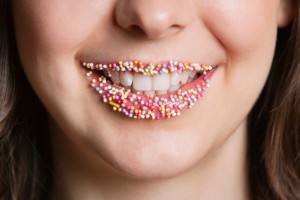
Don’t deny yourself your sweet treat. You can have your cake and eat it too. As long as you brush afterward!
The term “sweet tooth” was coined in the 1300s when people described someone with a liking for delicacies, sweet or not, as having a sweet tooth. Over time the phrase began to refer to people who enjoyed sweets after refined sugar was introduced after explorations in the tropics of Asia. Today the term is used for people who experience cravings for sweets. But what happens when these sweets turn dangerous and give you cavities? Well, we’re in luck. We can help protect you from these cavities so you can have your cake and eat it too!
What are Cavities?
The term “cavities” is used to describe tooth decay. This decay occurs when bacteria in your mouth produce an acid that destroys the tooth’s enamel, its hard outer layer, and dentin, its hard second layer. A cavity reveals itself in dark spots on your teeth and is accompanied by toothaches, sensitivity to sweet, hot, and cold food and drinks. It can also cause pain when you chew. There are some ways a sweet toothed person can help to prevent cavities from marring their mouth.
Out and About
Brushing often will help to get rid of the plaque that contains the cavity causing bacteria. But does this mean you should rush home after every meal and brush? No. But that doesn’t mean you shouldn’t brush while out. Thanks to modern dentistry, there are now portable toothbrushes you can use to help remove the plaque while living your life normally. Whether you prefer carrying around a travel sized toothbrush and paste or use disposable toothbrushes with toothpaste built in, you should brush often. After eating something sweet like a snack or dessert, excuse yourself to the restroom for a quick brush to get rid of the sugar. If carrying around a toothbrush isn’t for you, carry around a mouth rinse instead to help remove as much sugar and sticky residue as possible.
At Home
Another thing you can do is to change your toothbrush more often at home. People with sweet teeth are at more risk for plaque buildup than the average person since plaque thrives in carbohydrate-rich environments. Try a toothbrush with triple-action action bristles and a diamond-shaped head to reach the hard-to-reach nooks and crannies of your mouth.
Substituting can be just as satisfying for your sweet tooth. Choose snacks that aren’t as sticky and won’t coat your mouth as much as others. For example a piece of pound cake won’t coat your mouth in sugar as much as a piece of taffy will. Choose something that won’t stick around for very long and remember to take care of your pearly whites as often as possible!
Catonsville Dental Care
Regularly seeing your Catonsville Dental Care dentist will help to determine if your child’s dental routines need modifications. For more information on pediatric dental care as well as other preventative dental care services, call Catonsville Dental Care today! Call today at 410-747-1115, or submit any questions by visiting CatonsvilleDentalCare.com.
Don’t forget to check us out and review our practice on Google+!
